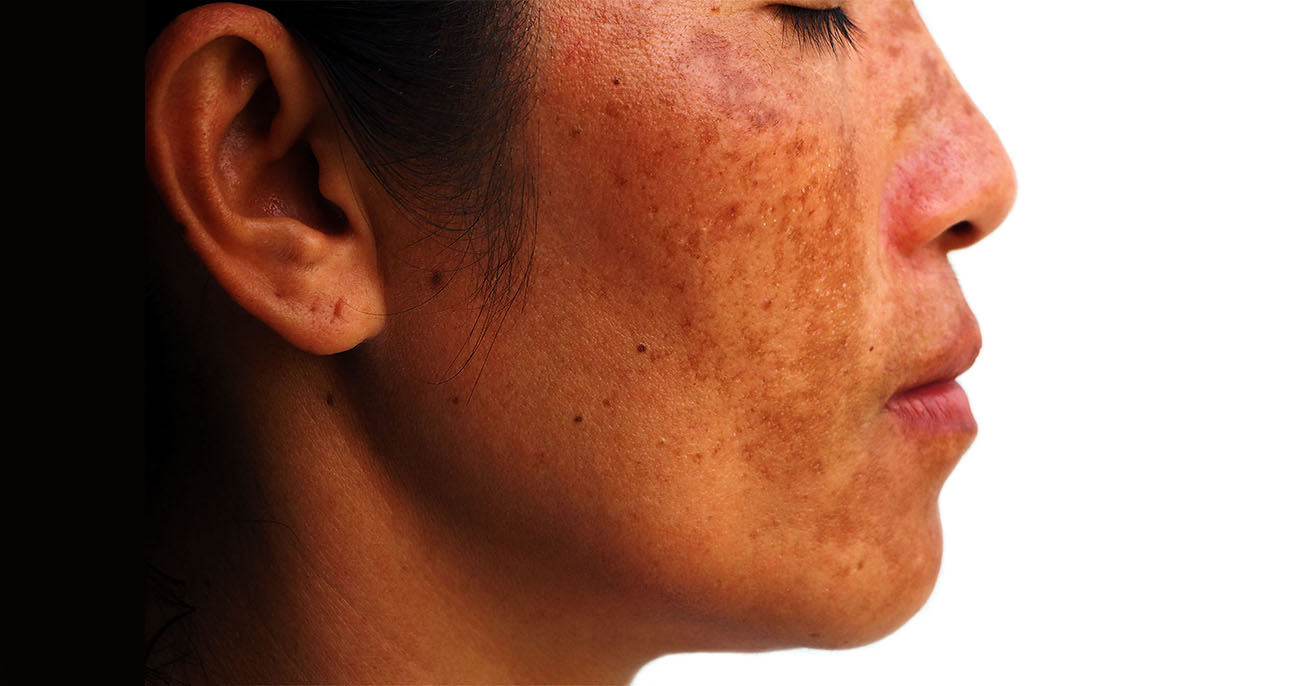A disfiguring, a chronic and challenging skin condition that presents as a brown to grey-brown patches mainly on upper cheeks, forehead, bridge of the nose, upper lip and chin.
What Factors Cause Melasma?
Genetics
Hormonal: Pregnancy, Menopause, Oral Contraceptive Pills, Hormone therapy
Sun Exposure
What Are The Treatments For Melasma?
Topical Agents
Sun Protection Cream
Direct sun exposure makes melasma worse…so a daily application of sun protection factor(SPF) of at least 50 that contains physical blockers such as zinc oxide and titanium dioxide is a must! Take note that chemical blockers may not fully block both UVA and UVB as effectively as physical blockers. Regular use of sun protection enhances the effectiveness of melasma treatments.
During prolonged periods of direct sun exposure such as during holidays or work, an additional application is required every 1-2 hours during exposure. Oral sunblock Is also highly recommended.
During prolonged periods of direct sun exposure such as during holidays or work, an additional application is required every 1-2 hours during exposure. Oral sunblock Is also highly recommended.
Lightening Creams
In the clinic, only medical-grade creams are prescribed both for effectiveness and safety.
Hydroquinone(HQ) is the most effective lightening cream. It works by blocking the natural chemical process in the skin responsible for creating melanin. Since melanin is responsible for dark skin pigmentation, reducing melanin will reduce melasma. Once optimal lightening has been achieved patient is then put onto non HQ products. It is imperative that patients on HQ products are followed up closely for side effects such as irritation and ochronosis.
Tretinoins are commonly used as add on to hydroquinone. It speeds up exfoliation and replacement of skin cells. Usually, treatment creams can contain HQ and tretinoin or triple creams that contain HQ, Tretinoin and Steroid. Tretinoin can cause irritation and best used under medical supervision.
Cyspera is the latest and a very effective lightening product for melasma Non HQ product that is used as a mask to reduce hyperpigmentation
Kojic acid, Azelaic acid, Vitamin C are used commonly as a substitute for HQ as melasma is a chronic condition that requires continuous maintenance of the lightening process. All 3 work to reduce melanin production. They are not as effective as hydroquinone, thus used together with HQ or as replacement of HQ after lightening achieved.
Chemical peels
Chemical peels, especially the Obagi Blue Peel are the most effective treatment for melasma. It lightens as well as repair the skin at the same time…. Read more
Q Switch laser
Laser toning is a procedure where Q switch laser is used a repetitively using lower energy to reduce pigmentation
However, lasers are not first-line treatments because they can either aggravate melasma causing more darkening or adverse effects such as white spots, hypopigmentation. This is more so with darker skin types. Thus such treatments should be done under the hands of a skilled and experienced doctor. Laser toning is a procedure where Q switch laser is used a repetitively using lower energy to reduce pigmentation
Skin Booster Treatment
The Polynucleotide Healer helps to lighten pigmentation by repairing the compromised skin.
Moisturizing effect by hyaluronic acid in Hyaluronic Acid Skin Booster Treatment has shown to be effective in lightening hyperpigmentation. Read more on Skin Boosters
Medical Facials
The PDRN Facial uses microdermabrasion for exfoliation and a PDRN serum that helps with lightening and repair of the skin. Best done 2 weeks after a chemical peel… read more on Medical Facials
How Often Is Treatment Required?
Skincare regime that comprises of sun protection and lightening cream is a Must for many years of a women’s life as melasma takes many years to disappear. Once the skincare regime is stopped, the melasma returns.
Treatments such as chemical peels and/or medical facials help to maintain the results of initial treatments which will effectively lighten the melasma.




